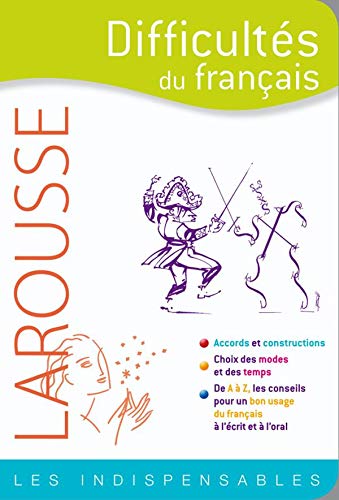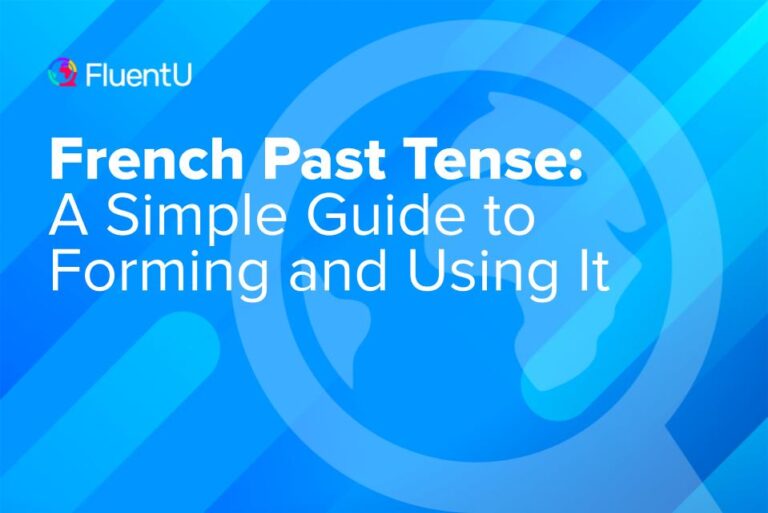The Complete Guide to Core French Grammar Topics

Without grammar, French wouldn’t be so beautiful. The building blocks and structure of the French language would lack order, finesse and its well-loved prestige.
And although French language learners tend to find grammar intimidating, the topic hardly deserves its bad rap.
In fact, French grammar isn’t that difficult to grasp.
In this post, we’ll look at all the major topics in French grammar, boiled down to their most basic concepts for easy consumption (with links to our deep dives on each topic.) To make it easier, we’ll throw in examples with audio clips to help with pronunciation.
Download: This blog post is available as a convenient and portable PDF that you can take anywhere. Click here to get a copy. (Download)
1. Nouns
Like in English, a noun in French generally denotes a person, place or thing.
These nouns can be concrete, meaning they can be physically found in the real world like a building or a person, or they can also be abstract, like an idea: equality or freedom.
Nouns can also be proper or common. Proper nouns have capital letters as their first letter and denote specific people, places or things, like these nouns:
- Marie – Marie
- Paris – Paris
- la tour Eiffel – the Eiffel Tower
Common nouns do not take capital letters, such as:
Gender
In short, every noun in French has a gender. That means nouns can be masculin (masculine) or féminin (feminine).
This seems logical for nouns that denote a person, but inanimate objects such as la table (the table) and le livre (the book) have genders too.
Some word endings in French follow patterns that let us know whether a word is masculine and feminine, but generally, it’s best to memorize the gender of the French word when learning it. Here a some examples of both genders:
Masculine nouns:
- le cerveau – the brain
- le poulet – the chicken
- un moment – a moment
Feminine nouns:
- L’amitié – friendship
- la sagesse – wisdom
- une baguette – a baguette
Number
Like in English, French nouns change when they become plural (more than one). The most basic form of this is by adding an -s as in English.
There are plenty of nouns that don’t follow that rule, however. Lucky for us, a lot of these nouns follow regular patterns. Once learned, they can be applied to most nouns with those endings with only a few exceptions.
Regular plural forms:
- Le stylo (the pen) becomes les stylos (the pens) in the plural.
- La table (the table) becomes les tables (the tables) in the plural.
Articles
Every noun in French needs an article. This article is determined by its gender, its number and whether you’re talking about a specific instance of that noun.
There are three indefinite articles in French that do not specify a particular noun:
- un (a/an [masculine])
- une (a/an [feminine]) for singular nouns
- des for plural nouns that means “some”
Definite articles do specify the noun being spoken about:
- le (the [masculine])
- la (the [feminine])
- les (the [plural])
Case
Noun case lets us know what a noun’s specific function is. Look at the following sentence:
- Le garçon donne le livre à sa mère – The boy gives the book to his mother.
In this sentence:
- le garçon is le sujet (the subject) of the sentence and in the nominative case.
- Le livre is the complément d’objet direct (the direct object) and in the accusative case.
- Lastly, sa mère is the complément d’objet indirect (the indirect object) and in the dative case.
All of these nouns have different functions in the sentence.
Unlike in other languages like German or Russian, the noun and its article do not change depending on their case (or function).
2. Verbs
These are perhaps the most intricate part of French grammar. Let’s check out why.
Action Verbs
The most common function of a verb in a sentence is that it is an action word. That means it shows what the sujet (the subject) of the sentence is doing.
These action word verbs can also take objects. For example in the sentence:
- Le chien mange la pomme – The dog eats the apple.)
La pomme is the complément d’objet direct (the direct object). This shows that the action of manger is being done to la pomme.
Verbs can also have a complément d’object indirect (the indirect object). These words are “receivers” of the verbs. For example, in the sentence:
- Je téléphone à la police – I’m calling the police.)
The noun la police is in the complément d’objet indirect position. This is shown with the preposition à (to).
Stative Verbs
Unlike action verbs, stative verbs do not determine an action. Instead, they denote a “state.” Stative verbs do not take complément d’objet direct or complément d’objet indirect nouns.
The most common of the stative verbs in French is the verb être (to be). Other common stative verbs include devenir (to become), sembler (to seem) and avoir l’air (to seem). Here they are used in sentences:
- Nous sommes sœurs. – We are sisters.
- Je suis américain. – I am American.
- Le chien semble malade. – The dog seems sick.
Infinitive
The infinitive of the verb is the unconjugated form, also known as the dictionary form. This is because you will see this form of the verb in the dictionary.
Often, the infinitive form of the verb is used when it follows a conjugated verb, as well as modal verbs:
- Je veux danser ce soir. – I want to dance this evening.
The infinitive form of the verb can also be used with impersonal expressions:
- Il est facile à décider. – It is easy to decide.
Verb Groups
In French, we often talk about regular and irregular verbs.
Regular verbs follow a pattern. These regular verbs can be put into three distinct groups based on the verb ending pattern.
The first group of regular verbs are verbs that end in -er. The second group of regular verbs are verbs that end in -ir. The last group of verbs includes those that end in -re. Here are some examples:
- Aimer. – to like, to love (-er verb)
- Changer – to change (-er verb)
- Finir – to finish (-ir verb)
- Dire – to say (-re verb)
The third group also includes verbs that do not follow a pattern based on their ending. These are known as irregular verbs. Here are some common irregular verbs:
Conjugation
Conjugation describes how a verb changes in order to agree with the subject and the tense of the verb. Verb conjugation often follows simple formation rules.
Each verb contains two things: a root and an ending. The root can also be called the “radical” or the “stem,” but it is the unchanging part of the verb.
The ending is where verb conjugation occurs. These change depending on the subject and tense of the verb. Here is one verb’s conjugation in the present tense:
- J’ai – I have
- Tu as – You have
- Il/Elle a – He/She has
- Nous avons – We have
- Vous avez – You have [plural]
- Ils/Elles ont – They have
3. Tenses
A verb tense anchors a verb in time. In other words, it lets us know when a certain verb is happening.
French has around 20 verb tenses. This number, however, uses the word “tense” liberally, choosing to mean all the ways a verb can change. However, if we take the word “tense” to only talk about a verb in time, there are far fewer tenses.
For now, let’s look at the eight basic and compound tenses.
1. Le présent is the present tense in French. This is the tense that lets us know that an action is happening right now. It is important to note that the French present tense encompasses different present tenses from English.
- Nous chantons. – We sing/We are singing/We do sing)
2. Le passé composé is a compound tense that is used to talk about the perfect past in French. It is a compound tense because it has two verb pieces: an auxiliary verb, être (to be) or avoir (to have), and the main verb with a changed ending.
- J’ai parlé. – I spoke.
3. L’imparfait is actually both a tense and an aspect of French, and it is commonly taught alongside the passé composé. That is because it also talks about the past. Rather than talking about a single past action, however, the imparfait talks about an action that is repetitive or continuous in the past, but not completed.
- Elles marchaient. – They were walking.
4. Le passé simple is a third past tense in French, but it is rather historical, can seem archaic and it’s not really used in spoken French. It is, however, used extensively in French books, old and new. Rather than being a compound tense like the passé composé, le passé simple changes a verb’s ending to show its tense, but it has the same meaning as the passé composé.
Pendant que je visitais Saint-Malo, je pris beaucoup de photos. – While I was visiting Saint Malo, I took a lot of photos.
5. Le plus-que-parfait translates to the “more than perfect” tense in English. It uses the imparfait of an auxiliary verb (être or avoir) as well as the past participle. It shows past actions that have happened before other past actions.
- J’avais lu le livre avant qu’elle est arrivée. – I had read the book before she came.
6. Le futur simple is the future tense. It is created by adding endings to the infinitive form of the verb. It encompasses the meaning of “will” and “going to” in English.
- Vous mangerez la pizza. – You will eat pizza/You are going to eat pizza.
7. Le futur proche is a verb construction used to talk about the near future, akin to the English “am/are going to.” It is formed by using the appropriate conjugation of aller in the present tense plus an infinitive.
- Va aller à la plage. – We are going to go to the beach.
8. Le futur antérieur talks about a future action that will have occurred. It uses the future tense of an auxiliary verb, être or avoir, as well as the past participle.
- J’aurai fini mes devoirs à 21h. – I will have finished my homework at 9:00 p.m.
4. Aspects
Remember how we said there were eight true verb tenses?
Well, there are also four verb aspects. Rather than pinning a verb to a specific moment in time, an aspect lets us know how that verb relates to the passing of time.
Habitual
The aspect habituel (habitual aspect) is just how it sounds: it describes actions that are a habit. It lets us know that an action occurs regularly. This aspect is not reflected in the verb’s conjugation: the verb conjugates normally as it would for the past, present or future. Instead, additional words let us know that the action happens regularly.
Perfect
Unlike the aspect habituel, the aspect perfectif (perfective aspect) is reflected in a change in the verb ending. We’ve already met this aspect: it shows an action that is complete, has been completed or will be completed.
In fact, this is the entire idea behind the passé composé. It shows that an action has been completed in the past. The passé composé is perfective because the action has been completed.
Imperfect
Opposite to the aspect perfectif is the aspect imperfectif. This aspect lets us know that an action is not completed. This can occur in any tense, but it is shown in the verb endings of a verb tense that we already know. You guessed it: the imparfait.
Progressive
The progressive aspect is one that is employed in English but does not have any special verb conjugations in French. This aspect expresses an action that is in the middle of occurring. In English, we might say “the dog is running” or “the boy is jumping,” but in French, we would just use the regular present tense.
If we want to emphasize this aspect, however, we can add supplementary details to the sentence. For example, en train de (in the middle of) emphasizes the progressive aspect of a sentence.
5. Mood
Verb mood reflects the speaker’s mood toward what they are saying. Most of the time, it lets us know how factual a sentence is or how confident the speaker is that a certain sentence is the truth.
Indicative
The indicative mood lets the listener know that the speaker is pretty confident about what they are saying. In fact, the indicative mood lets us know that what is being conveyed to us is fact (or the speaker believes it is fact).
We’ve already reviewed the eight tenses attached to the indicative mood: they are the eight moods listed above in the “Tenses” section.
Imperative
The imperative mood is also known as the command form: it is the mood used to give commands, requests or instructions.
There are technically two tenses attached to the imperative mood. L’impératif présent (the present imperative) gives simple commands such as Mange ! (Eat!).
The second is called the impérative passé (the past imperative) and is literary. It is used to give a command through the past tense.
Conditional
The conditional mood corresponds to the idea of “would” in English. The speaker is using hypotheticals, often hinging on the idea that if something occurred, something else would also occur.
As in English, this can be expressed in French in two tenses: the present and the past.
Here’s an example of the conditional:
- Si j’étais riche, j’achèterais une île. – If I were rich, I would buy an island.
Subjunctive
The subjunctive mood is used to express doubt, desire or even fear. It can be used for proposals and demands. There are also set expressions which trigger the subjunctive, notably in subordinate clauses following que.
For example:
- Je doute que tu saches la résponse. – I doubt that you know the answer.
Sais (you know) becomes saches in the subjunctive mood reflecting that doubt.
The subjunctive is most commonly used in the present and past perfect tenses, though you may spot it elsewhere.
6. Adjectives
Like in English, adjectives in French describe a noun.
Endings
Adjective endings in French can change depending on the gender of the noun that the adjective is modifying. It can change further depending on whether or not the noun is plural.
For example:
- L’homme est européen. – The man is European.
- Le femme est européen. – The woman is European.
- Les garçons est européens. – The boys are European.
Adjective endings follow regular patterns, but some are irregular.
Placement
The majority of adjectives in French come after the noun they describe. This is true for all of les adjectifs attributs (attributive adjectives).
For les adjectifs épithètes (epithetic adjectives), most are placed after the noun, but there is a selection of shorter adjectives that are placed before the noun.
Some adjectifs épithètes can be place placed before or after the noun. The placement of these adjectives changes their meaning slightly.
Les adjectifs attributs
An adjectif attribut is separated from the noun with a verb. Most commonly, this verb is être (to be).
For example:
- Le fille est adorable. – The girl is cute.
Les adjectifs épithètes
An adjectif épithète is one that emphasizes a certain characteristic of a noun. As such, the adjective is placed right beside the noun, either before or after depending on which adjective it is and the meaning of the adjective.
For example:
- La jeune fille danse. – The young girl dances.
Comparative adjectives
Comparative adjectives compare two nouns. These adjectives are introduced by the adverb phrases plus… que (more than), moins… que (less than) and aussi… que (as… as).
For example:
- Le chien est plus grand quele chat. – The dog is bigger than the cat.
There are some comparative adjectives that are irregular and do not follow the patterns above.
Determiners
Technically, determiners are adjectives, and they indicate which noun is being talked about. Definite and indefinite articles are determiners, and other common determiners include ce (this/that) and quel (which) as well as possessive adjectives such as mon (my), which show who owns the noun in question.
As expected, determiners change to reflect the gender and number of the following noun.
7. Adverbs
Unlike adjectives, adverbs describe verbs. They are most commonly used to describe how an action verb is being performed.
Adverbs can also modify adjectives or other adverbs.
Placement
Adverb placement is very strict in French. They always go after the verb they modify. If the verb is a compound verb (using an auxiliary), they go after the first verb.
If an adverb is modifying an adjective or another adverb, they precede the adjective.
Endings
Many adverbs are words of their own that do not have a specific ending. There is a selection of adverbs that end in -ment. These are generally derived from adjectives, as in the example of rapidement (quickly).
Types of Adverbs
There are categories of adverbs that are grouped together based on their function.
- Les adverbes de temps (adverbs of time) describe when a certain action is occurring. Examples include demain (tomorrow) and bientôt (soon).
- Les adverbes de manière (adverbs of manner) describe how a certain action is happening. Examples include lentement (slowly) and prudemment (carefully).
- Les adverbes de lieu (adverbs of place) describe the location where an action is occurring. Examples include dehors (outside) and ici (here).
- Les adverbes de quantité (adverbs of quantity) describe how much or how many of something there is. Examples include beaucoup (a lot) and peu (a little).
- Les adverbes de fréquence (adverbs of frequency) describe how often an action occurs. Examples include souvent (often) and parfois (sometimes).
- Les adverbes d’affirmation (adverbs of affirmation) let us know how credible an action is. Examples include certainement (certainly) and évidemment (evidently).
- Les adverbes de négation (adverbs of negation) are used to create the negative in a sentence. These are often used in combination with ne such as in ne… pas (not) and ne… jamais (never).
- Les adverbes de doute (adverbs of doubt) let us know that there is a degree of doubt in the sentence. Examples include peut-être (maybe) and possiblement (possibly).
- Les adverbes de question et d’exclamation (adverbs of question and exclamation) are a set of adverbs that can be used to ask an indirect question as well as to express an extreme emotion. Examples include quel (which) and comment (how).
- Les adverbes relatifs et comparatifs (relative and comparative adverbs) are used to compare two nouns using an adjective. These include plus… que (more than), moins… que (less than) and aussi… que (as… as).
8. Pronouns
Pronouns are used to replace nouns. There are different groups of pronouns used for a variety of reasons.
Personal
Personal pronouns take the place of an animate (mostly a person) noun in French. For example, you can replace the noun le garçon (the boy) with the pronoun il (he).
There is a set of personal pronouns for multiple functions in the sentence. While personal pronouns replace nouns in the subject position, some pronouns are used in place of the complément d’objet direct or the complément d’objet indirect.
Possessive
Possessive pronouns allow us to know who owns a particular noun in question.
For example:
- C’est mon livre. – It’s my book.
As expected, these possessive pronouns must agree with the gender and number of the following noun.
Reflexive
Reflexive pronouns show that an action reflects back to the subject of the sentence.
For example:
- Tu te brosses les dents. – You brush your (own) teeth.
Each subject pronoun has its own corresponding reflexive pronoun.
Relative
Relative pronouns link together two different clauses in a single sentence. These clauses, when unjoined, would constitute separate sentences.
For example:
- Le livre que j’ai lu est magnifique. – The book that I read is magnificent.
Interrogative
Interrogative pronouns are used to ask questions in French.
For example:
- Qui aime les biscuits ? – Who likes cookies?
Demonstrative
Demonstrative pronouns refer back to a previously mentioned noun. As expected, these pronouns must agree in gender and number with the noun. The particles -ci and -là can be used to add emphasis.
For example:
- Regarde la chemise. Celle-ci est rouge. – Look at the shirt. This one is red.
Indefinite
Indefinite pronouns are used to refer to a noun that is unspecified or unknown. These also agree in number and gender with the noun (where possible).
For example:
- Ceci est petit – This is small.
Adverbial
There are two adverbial pronouns in French: y and en. Y is used to replace a location in French and en is used to replace a quantity.
For example:
- J’y reste. -I’m staying here.
- Il en mange cinq. – He eats five of them.
9. Prepositions
In short, prepositions are small words that show some sort of relationship between a noun, adjective or verb and the word placed after the preposition.
For example:
- Je viens de Paris. -I come from Paris.
Some prepositions such as à (to) and de (of, from) combine with the following definite article to change form slightly.
10. Conjunctions
Conjunctions are used to join two separate ideas or clauses within a single sentence.
Coordinating Conjunctions
Coordinating conjunctions are used to connect two clauses that are said to have the same value to the sentence. In general, these separate clauses could function as their own sentences.
For example:
- La fille a mangé du chocolat et le garçon a budu café. – The girl ate some chocolate and the boy drank some coffee.
Subordinating Conjunctions
Subordinating conjunctions connect two clauses that do not have the same value. The main clause can stand on its own, but the subordinating clause (or the dependant clause) could not be its own sentence.
For example:
- La livre que le garçon aimé est long. – The book that the boy liked is long.
11. Sentence Structure
Sentence structure in French is very similar to English. French follows a subject-verb-object word order, so English speakers should have no issue creating sentences in French.
There are a few particularities, however. In French, adverbs always follow the verb, and most adjectives follow the noun. Sentence structure also differs when asking a question.
12. Questions
There are two main ways to ask a question in French.
The first is an inversion of the subject and the verb as in the question as-tu un livre ? (do you have a book?). The second is to add the words est-ce que to the declarative sentence as in est-ce que tu as un livre ? (do you have a book?). These are the common forms for yes/no questions.
Question words can be added to yes/no questions for detailed answers.
For example:
- Que veux-tu ? Qu‘est-ce que tu vas manger ? – What do you want? What are you going to eat?
13. Exclamations
Exclamations are used to express a strong emotion in French. These can show amazement, shock, anger or disappointment.
For example:
- Oh là là ! Il fair chaud aujourd’hui. – Oh my! It is hot today.
14. Casual Speech
In casual or informal speech, it is not uncommon for French grammar rules to be broken. In these cases, the sentences may be ungrammatical but still understood.
Check out some commonly broken grammar rules that are used in casual speech.
Dropping the ne in the negative is one of the most common markers of casual speech.
- Je sais pas ce que tu veux. -I don’t know what you want.
Using casual personal pronouns also mark casual speech. In most cases, tu is used to mean “you” instead of the formal vous, and on is used for “we” instead of the formal nous.
Shortening common phrases and words such as tu to t’ and il y a (there is) to y a happens in French casual speech.
Ça (that) is used in place of all demonstrative and indefinite adverbs in French informal speech.
Questions use intonation rather than inversion or est-ce que. Instead, the voice raises at the end of the sentence to indicate a question.
And there you have it, all tied together with a pretty little bow. French grammar really can be summarized in a single post, and now you’re ready to make it yours!
15. Resources and Tips to Help with Learning French Grammar
Begin with the Basics
Things like “Where is..,” “What is…,” “How,” “I am,” “There is,” “What” and “He has” come to mind.
Having knowledge of the basic verb tenses, pronouns and question words in these everyday phrases will help you build a strong foundation for your French.
In basic conversation, we use the present tense more than anything. Simple building blocks like “He is,” “We are” and “This is” all fall into this category.
We also consistently use several main kinds of verbs: “to be,” “to have” and “to go” are among the most common. It’s important to understand these foundational elements, since we use them so often in conversation.
Focusing on the simpler aspects of French grammar won’t only help you learn French the right way—you’ll feel accomplished for conquering the basics and motivated to keep learning and move beyond them.
Make Connections to English
In order to achieve fluency, you’ll eventually have to learn how to separate French and English and stop translating into English when you hear a French phrase.
However, when you first begin learning, making connections (and noting differences) with English will help you establish a working knowledge of French faster than if you approach it with no knowledge at all.
Use what you know!

As we’ll discuss later, books like “English Grammar for Students of French” are great tools for taking the knowledge you have of your native tongue and leveraging it to learn French. “Side-by-Side French and English Grammar” is another wonderful tool for comparing the two languages.
Some basic similarities between French and English:
- English requires an article before a noun, such as the or a. French is the same way, using le/la/les (the) and un/une/des (a/some) in similar ways, although there are some important differences!
- Both languages use the same sentence structure—subject-verb-object.
- There are several ways to ask questions in French, but a colloquial way to ask questions is exactly the same as in casual English—with a voice inflection at the end indicating interrogation.
Understand Verb Tenses and How They Work
As in any language, verbs are a basic part of every sentence. Learning them is just as important as learning new nouns, adjectives and pronouns. Spending time with a pencil and a book like “501 French Verbs” is a crucial part of starting your French learning. This is where your memorization skills come in.
Focus on learning basic, irregular verbs and regular verb conjugations, like the following:
- être – to be [irregular]
- avoir – to have [irregular]
- aller – to go [irregular]
- parler – to talk [regular]
- finir – to finish [regular]
- attendre – to wait [regular]
To be, to have, and to go aren’t only daily verbs but also foundations for other tenses beyond the present, such as passé composé (past tense).
Verbs with the stem -er, -ir, and -re are all recurring verbs in French, and if you learn the conjugation of one, you’ll learn the conjugation of them all (with some exceptions, of course!). This is essential, because many of the verbs you’ll want to use are regular and therefore have the exact same conjugation structure.
Track Down the Best Resources for Beginner French Grammar
Luckily, there’s a plethora of resources out there for new French language learners, from tried-and-true grammar books to online resources.
Here, I’m going to provide you with the 5 best resources out there.
“501 French Verbs”

Another great perk in the updated versions? The authors mark 55 verbs that you need in your vocabulary and even give sentences and idioms where you’d typically use those verbs.
Though the book retains its title “501 French Verbs,” it goes far beyond just 501 verbs. lt even includes an appendix with 1001 verbs that are conjugated similarly to the 501 already explained.
For French learners, it’s one of the most essential books—and one of the most worthwhile investments.
“Difficultés du français”

The book is written entirely in French, so this is best used after you’ve established a solid foundation of the basics. I’ve found it to be one of the most revealing and eye-opening tools for learning the (often strange) ins and outs of French grammar.
“English Grammar for Students of French”

Each chapter has two parts. First, general grammar concepts are explained in English, preparing readers for the concepts necessary to grasp French. Next, the same grammar is explained as it relates to French, with examples of those rules being applied. Each chapter explains a different grammar point: a part of speech, a word’s function in a sentence or a grammar term like “tense,” “gender” or “agreement.”
BBC French

Courses like Ma France will guide you as you establish a working knowledge of French grammar. The French phrases resource will introduce you to French slang and common phrases that you can start incorporating into your conversations.
It’s a catch-all website that contains a lot of great, fun resources for French beginners.
Tex’s French Grammar

The creators had a sense of humor, because the website is designed to help students learn grammar through cartoons. The grammar concepts are separated into various categories (verbs, nouns, sentence structure, etc.), explained in English and then used in a dialogue. Quizzes accompany each lesson to reinforce the learned information.
The site also includes a verb tutor and a conjugator for additional help beyond “501 French Verbs.”
Filled with comprehensive lessons and detailed instruction, Tex’s French Grammar is one of the best online tools for beginning French learners.
Remember, grammar can be tackled and it’s not as difficult as it first seems. Practice is the key, so read over this post often and check the resources mentioned for even more help.
Best of luck on your grammar journey!







